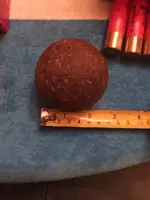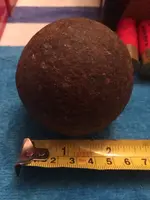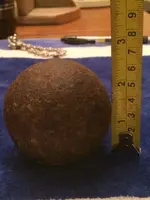Coinhound1983 wrote:
> Help me out, what type measurements and or diff pics.
Everything you need to know, including detailed how-to instructions and helpful photos, is in an article I co-wrote with David Poche, here:
SolidShotEssentialsMod
When you've accomplished the super-precise weighing and measuring, we'll look for a match-up here:
Cannon bore, shot, and shell diameters for smoothbore guns
If there's no exact match-up, it is not an Artillery ball.
I should mention, a metal ball's "original" weight can be reduced somewhat by corrosion. Also, air bubbles trapped inside the ball during the metalcasting process can also cause it to weigh somewhat less than its diameter would indicate. But a cast-iron Artillery ball will never be heavier than its diameter should indicate.
Since you've provided a photo showing a wide steel Carpenter's measuring-tape wrapped around the ball, while we wait for precise diameter measurement, let's go with what the metal tape (which is inexact) shows:
circumference is 7 & 7/8th inches (7.875 inches)
diameter equals circumference divided by Pi (3.1416)
7.875 inches divided by 3.1416 equals 2.507 inches.
There is no 2.50-inch Artillery ball.
So, because I actually always hope that a digger has found an Artillery ball, I'm hoping precise weighing and measuring will produce a happier result for you and me than measuring the ball with a wide steel tape.
Sidenote:
When a digital caliper is either unavailable or isn't large enough to fit around a big ball, we use what is called a Diameter-Tape. Although it is a steel tape, it is narrow enough that we can position it easily across the exact center of the ball. See the photo below, which is in the instructional article I gave you the link for. If the tape is positioned off-center (in other words, not EXACTLY on the ball's "equator"), the measurement will be inaccurate.










